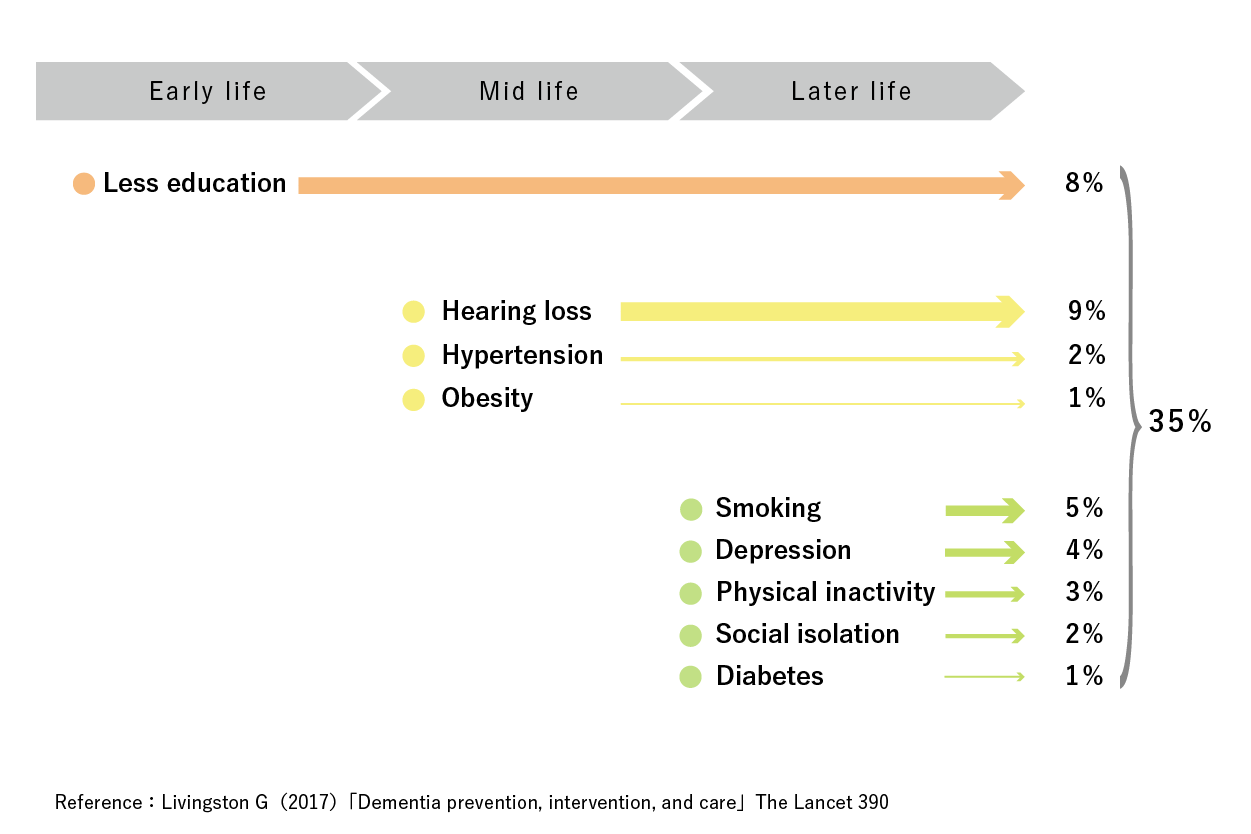[HGPI Policy Column] No. 18 – From the Dementia Policy Team – Considering the Importance of Global Efforts from Multi-Stakeholders for Issues in Dementia in Terms of Dementia Risk Factors
date : 10/9/2020
Tags: Dementia, HGPI Policy Column
![[HGPI Policy Column] No. 18 – From the Dementia Policy Team – Considering the Importance of Global Efforts from Multi-Stakeholders for Issues in Dementia in Terms of Dementia Risk Factors](https://hgpi.org/en/wp-content/uploads/sites/2/column-top-dementia.jpg)
Key Points
– The latest Lancet Commission report presented by Professor Gill Livingston of University College, London (UCL) added three new potentially modifiable risk factors for dementia to the nine factors described in a previous report from 2017. They are traumatic brain injury, excessive alcohol consumption, and air pollution.
– People in low- and middle-income countries (LMIC) face more risk factors and are at greater risk of dementia than people in high-income countries.
– Dementia risk factors are rooted in many domains and exist throughout the life course. Furthermore, risk factors vary among countries. Eliminating risk factors will require efforts from multi-stakeholders on a global scale.
Our previous dementia column discussed recommendations from the Ministry of Internal Affairs and Communications (MIC) on dementia policy based on the results of a third-party evaluation survey that was presented on May 12, 2020 which examined Initial-phase Intensive Support Teams for Dementia and medical centers for dementia. The authority to decide policy rests with the legislative branch, or the Diet, but members of civil society are responsible for shouldering a portion of that burden by electing representatives in the policy decision making process. Therefore, we concluded that members of civil society must take action to improve policy.
As the lives of many depend on healthcare policy, discussions in this field place a strong emphasis on scientific evidence. In this column, we would like to discuss a recent report published in The Lancet, which is a renowned international journal of medical science and is highly-trusted in a field that values scientific evidence.
The Three New Potentially Modifiable Risk Factors
In a report published in The Lancet in 2017, UCL’s Professor Gill Livingston and her team identified nine potentially modifiable risk factors for dementia. That report then calculated the population attributable fraction (PAF)*1 for those nine factors. The PAF for the nine risk factors was 35% (Figure 1), meaning that 35% of the population would not have developed dementia had all nine risk factors been absent. To draw that conclusion, the report conducted a comprehensive analysis of multiple studies using systematic reviews and meta-analyses.
Professor Gill Livingston’s latest report is entitled, “Dementia prevention, intervention, and care: 2020 report of the Lancet Commission,” and was published in the July 30, 2020 edition of The Lancet. It identified three new potentially modifiable risk factors, which were traumatic brain injury, excessive alcohol consumption, and air pollution, making a total of twelve risk factors with a total PAF of 40% (Figure 2).
In addition to injuries sustained in vehicular accidents involving cars, motorcycles, and bicycles and injuries sustained in battle, traumatic brain injuries can also occur in various sports such as boxing and horseback riding.
The report defined “excessive alcohol consumption” as 21 units per week or 3 units daily. One unit contains 8 g of pure alcohol, so in terms of pure alcohol intake, those standards would equate to 168 g per week or 24 g per day. However, Health Japan 21 (the second term) states that the daily amount of pure alcohol consumption associated with increased risk of lifestyle diseases is 40 g or more for men and 20 g or more for women, so the definition of “excessive alcohol consumption” in terms of pure alcohol intake used in the report was more stringent than health standards in Japan.
Air pollution generally increases the risk of non-communicable diseases. The report analyzed air pollution and discovered that exposure to pollutants such as PM2.5, nitrogen dioxide, and carbon monoxide from sources such as traffic exhaust and residential wood burning were associated with increased dementia risk.
People in Low- and Middle-Income Countries Face Greater Risk
The report also concluded that dementia risk is higher in LMIC compared to high-income countries. Calculating PAF (Figure 1) using the nine potentially modifiable risk factors described in the 2017 report by country results in a PAF of 40% for China, a PAF of 41% for India, and a PAF of 56% for Latin America, and these numbers may be even higher depending on which estimates of risk factor frequency are used. It is likely that the situations in such countries will improve if measures are implemented to address poor access to education, causes and management of high blood pressure, causes and treatment of hearing loss, and socioeconomic and commercial factors that cause obesity.
The Significance of Global Efforts for Dementia by Multi-stakeholders
This column discussed dementia risk factors identified in a recent report published in the medical journal The Lancet. As the report showed us, potentially modifiable risk factors for dementia exist across many domains. In addition to healthcare, the factors are related to education and all fields of industry, and they are present throughout the life course. Instead of an approach from a specific field that targets a specific age group, reducing or eliminating these risk factors will require understanding of dementia from all of society. Also, people in LMIC are at greater risk, so cooperation from international society will be absolutely essential to find solutions.
We must not forget that 60% of risk factors were “Unknown,” so more than anything, it is necessary for each individual, every family, and all of society to be prepared to provide mutual support so that everyone can continue living as well as possible even if someone develops dementia.
*1 Population Attributable Fraction (PAF):
“Attributable” refers to attributable risk, which describes the degree to which chances of developing a certain disease increase after exposure to a certain risk factor. PAF is the ratio of people who develop the disease among a population that has been exposed to a certain risk factor to indicate the real-world effects of exposure. In other words, PAF allows us to estimate the ratio of people who would not have developed a disease had they not been exposed to a certain risk factor.
Works referenced
MHLW, “Health Japan 21.”
Japan Epidemiological Association. “Attributable Risk and Attributable Risk Ratios.”
Livingston et al, 2020. “Dementia prevention, intervention, and care: 2020 report of the Lancet Commission.” The Lancet, 396, 413-446.
About the author
Shunichiro Kurita (HGPI Manager; Steering Committee Member, Designing for Dementia Hub)
< HGPI Policy Column (No.19) -from the Dementia Policy Team-
Top Research & Recommendations Posts
- [Research Report] Perceptions, Knowledge, Actions and Perspectives of Healthcare Organizations in Japan in Relation to Climate Change and Health: A Cross-Sectional Study (November 13, 2025)
- [Research Report] The 2025 Public Opinion Survey on Healthcare in Japan (March 17, 2025)
- [Policy Recommendations] Mental Health Project: Recommendations on Three Issues in the Area of Mental Health (July 4, 2025)
- [Research Report] The 2023 Public Opinion Survey on Satisfaction in Healthcare in Japan and Healthcare Applications of Generative AI (January 11, 2024)
- [Policy Recommendations] Developing a National Health and Climate Strategy for Japan (June 26, 2024)
- [Announcement] HGPI Endorses the “Belém Health Action Plan” (November 14, 2025)
- [Policy Recommendations] Recommendations on Strategic Investments in Policies for Brain Health to Revitalize Japan: Hopes for the New Administration (December 1, 2025)
- [Policy Recommendations] Reshaping Japan’s Immunization Policy for Life Course Coverage and Vaccine Equity: Challenges and Prospects for an Era of Prevention and Health Promotion (April 25, 2025)
- [Announcement] HGPI Joins Global Green and Healthy Hospitals (August 1, 2023)
- [Research Report] Survey of Japanese Nursing Professionals Regarding Climate Change and Health (Final Version) (November 14, 2024)
Featured Posts
-
2025-12-09
[Event Report] Special Seminar “Rising to New Challenges in Health Sciences for Future Society: Novel Developments in the Field of Epilepsy in Japan and Globally” Belgium Pavilion Special Seminar, World Expo 2025 Osaka, Kansai (September 18, 2025)
![[Event Report] Special Seminar “Rising to New Challenges in Health Sciences for Future Society: Novel Developments in the Field of Epilepsy in Japan and Globally” Belgium Pavilion Special Seminar, World Expo 2025 Osaka, Kansai (September 18, 2025)](https://hgpi.org/en/wp-content/uploads/sites/2/HGPI_20250805_mental-health-expo-eyechatch.png)
-
2025-12-11
[Event Report] Core Components of Universal Health Coverage (UHC): Achieving “Healthcare Without Financial Hardship” in Asia-Pacific and Japan (December 5, 2025)
![[Event Report] Core Components of Universal Health Coverage (UHC): Achieving “Healthcare Without Financial Hardship” in Asia-Pacific and Japan (December 5, 2025)](https://hgpi.org/en/wp-content/uploads/sites/2/HGPI_20251210_Core-Components-of-Universal-Health-CoverageUHC-top.jpg)
-
2025-12-12
[Registration Open] Meaningful Involvement Promotion Project Urgent Symposium “The New Takaichi Administration and Central Social Insurance Medical Council Reform – Ensuring Patients’ Voices are Heard” (January 22, 2026)
![[Registration Open] Meaningful Involvement Promotion Project Urgent Symposium “The New Takaichi Administration and Central Social Insurance Medical Council Reform – Ensuring Patients’ Voices are Heard” (January 22, 2026)](https://hgpi.org/en/wp-content/uploads/sites/2/HGPI_20251208_urgent-symposium-1.png)
-
2025-12-12
[Registration Open] (Webinar) The 140th HGPI Seminar “Early Detection to Reduce COPD Disease Burden: Connecting Clinical Frontiers with Health Policy” (January 27, 2026)
![[Registration Open] (Webinar) The 140th HGPI Seminar “Early Detection to Reduce COPD Disease Burden: Connecting Clinical Frontiers with Health Policy” (January 27, 2026)](https://hgpi.org/en/wp-content/uploads/sites/2/hs140-top.png)
-
2025-12-16
[Discussion Points] Policy Dialogue “Considering Comprehensive Genomic Profiling from the Perspective of Patient Access: Utilizing the Medical Service Fee Reimbursement System and the Mixed Medical Services Program to Meet the Needs of Today” (November 28, 2025)
![[Discussion Points] Policy Dialogue “Considering Comprehensive Genomic Profiling from the Perspective of Patient Access: Utilizing the Medical Service Fee Reimbursement System and the Mixed Medical Services Program to Meet the Needs of Today” (November 28, 2025)](https://hgpi.org/en/wp-content/uploads/sites/2/eyecatch_Policy-Dialogue_Discussion-Points_20251128.jpg)






